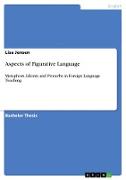Aspects of Figurative Language
BücherAngebote / Angebote:
Bachelor Thesis from the year 2010 in the subject English Language and Literature Studies - Linguistics, grade: 1, 7, University of Hannover (Englisches Seminar), language: English, abstract: The paper deals with different types of figurative language and the question of why and how these should be taught in second language teaching. In order to prove that figurative language is essential in communication and therefore needs to receive more attention in schools, I start by analysing and comparing the concepts of metaphors, idioms and proverbs.
Many scholars have discussed metaphors and so as to outline the most important aspects, I refer to Lakoff, Johnson, Ortony and Langlotz amongst others. Those aspects will include the differences between novel and conventional metaphors, the different functions that metaphors fulfil and the phenomenon of mixed metaphors.
When discussing idioms I focus on their relationship to metaphorical language, the aspect of frozenness and their functions as well as other topics. Here, scholars like Swinney, Skandara and Götz are quoted and their propositions towards idiomatic language are analysed.
To end the first part of the paper I discuss the relationship of proverbs to metaphors and idioms and base this part on Norrick in order to focus on didactic content and the issue of distinguishing between a proverb's literal and figurative meaning.
After having given the survey of those concepts, I turn to the part of explaining why it is so important to teach figurative language and I do that by drawing on Ortony's theses of compactness, inexpressibility and vividness. Furthermore, Katz's theory of metaphor as politeness is examined and also Liu's view on idioms as containing cultural references.
To end this theoretical paper with an idea of how to use the information practically, the last section deals with the question of how figurative language is best taught. The methods presented are based on a preceding part of background information on how the comprehension process of figurative language works and what the prerequisites are for being able to learn that part of a foreign language. This last part of the paper is mainly based on Ortony, Gentner, Liu and Ur.
Eventually, I conclude the paper by summing up the findings and evaluating their relevance for teaching figurative language in second language learning in schools.
Folgt in ca. 10 Arbeitstagen
